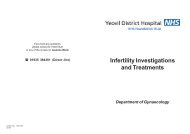Insulin administration - Yeovil District Hospital NHS Foundation Trust
Insulin administration - Yeovil District Hospital NHS Foundation Trust
Insulin administration - Yeovil District Hospital NHS Foundation Trust
You also want an ePaper? Increase the reach of your titles
YUMPU automatically turns print PDFs into web optimized ePapers that Google loves.
5.1 The section on self medication within the <strong>Trust</strong>’s Medicines Management Policy<br />
must be adhered to; this includes appropriate, documented assessment of the<br />
patient for suitability for self medication. The patients ability to self medicate may<br />
alter several times during one admission and this should be documented on the<br />
assessment.<br />
5.2 Any proposed changes made to patients’ insulin doses should be communicated to<br />
the patient immediately.<br />
5.3 Some patients may give variable doses of quick acting insulin and adjust doses of<br />
longer acting insulin. The <strong>Insulin</strong> prescription chart should reflect this practice.<br />
5.4 Illness and admission to hospital are stressful events and blood glucose levels may<br />
rise as a result. Patients who are used to adjusting their own insulin doses should<br />
be encouraged to continue to do so as necessary.<br />
5.5 If patients are not mobile enough to access a ward sharps container they should be<br />
provided with a 1 litre sharps container at the bedside, in order to minimise the risk<br />
of sharps accident.<br />
6. Mixing insulin<br />
6.1 Many of the commonly used insulins are premixed e.g. Novo Mix 30. Some older<br />
insulin regimens involve the mixing of two different insulins in a syringe prior to<br />
<strong>administration</strong>. Soluble, or short acting insulins, such as Humulin S or Actrapid,<br />
and rapid acting insulins, such as Humalog or NovoRapid, must only be mixed<br />
with an isophane insulin, such as Humulin I or Insulatard.<br />
6.2 Under no circumstances should soluble insulins be mixed with Levemir or<br />
Lantus, or insulin zinc suspensions e.g. Hypurin Bovine Protamine Zinc.<br />
6.3 <strong>Insulin</strong> suspensions (cloudy insulins) must be mixed thoroughly by gently rolling -<br />
not vigorously as this will destroy the insulin molecule before drawing up. Contact<br />
the Diabetes Department on ext 4517 should you need further advice before<br />
mixing or giving insulins.<br />
7. <strong>Insulin</strong> delivery devices<br />
7.1 Subcutaneous insulin must be delivered via insulin syringes or with a commercial<br />
<strong>Insulin</strong> pen. Under no circumstances must intravenous syringes be used to<br />
measure and administer insulin doses.<br />
7.2 The standard insulin syringe used by the <strong>Trust</strong> is the BD 0.5 ml insulin syringe with<br />
an integrated 8mm needle. The ‘twin bin’ service will ensure that each clinical area<br />
has a sufficient supply of insulin syringes. (These must be stored separately from<br />
the 1ml IV syringes). <strong>Insulin</strong> pen needles can be obtained from pharmacy.<br />
7.3 Commercial insulin pens are available on prescription for people with diabetes<br />
using insulin therapy. If a patient starts insulin treatment whilst in hospital the<br />
3






